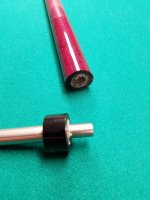For the Experts out there.....Ok, so I started to use a QR 3/8x10 flat minor pin on some break cues recently. I installed phenolic inserts that are 1.250" long at .560" dia. Drilled/bored to a .308 hole, then tapped with a tap with .308 pilot and the threads come out firm, but not tight. I have used brown linen and black canvas phenolic. most customers have had no problems, but 2 customers have bought them and they are the only ones that break in the 23-25mph range consistently. Both have come back within days with broken shafts, right at the collar...see pictures. The maple shaft sheared right at the collar, AND split the phen insert right down the middle, the purpleheart shaft split the wood slightly, but the phen still looks solid, just the part under the collar sheared off. Both sheared right where the threads stop on the pin, just by coincidence, I made the collar the same size as the thread length.
Now, has anyone else had this happen? I know that others use phenolic inserts without issues, is it the pin not being threaded all the way thru the insert, or is there something else going on? I love these pins, but can't have this keep happening.
Any insight is greatly appreciated,
Dave



Now, has anyone else had this happen? I know that others use phenolic inserts without issues, is it the pin not being threaded all the way thru the insert, or is there something else going on? I love these pins, but can't have this keep happening.
Any insight is greatly appreciated,
Dave


